Hummingbirds and Bats
of Southern Arizona
TRIP REPORT, 2011
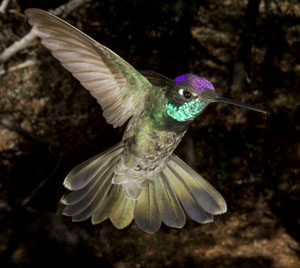
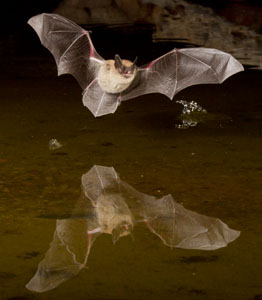
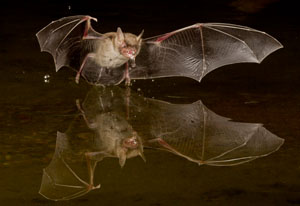
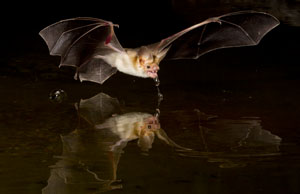
This year marked our 20th year of offering our Hummingbird High Speed Flash Photo Tour which was incorporated with our first full season of nocturnal Bat photography.
Because of the India Tiger Photo Safaris, we didn't arrive back in to the US until late April, we could only fit in three photo shoots spanning May 8th through May 23rd, which we compressed into back-to-back programs that gave Mary and me very little free time. Consequently, neither of us did very much photographing of hummingbirds, and with our files well-stocked with great images we were not too upset by this. Still, during those three shoots we had Magnificent, Broad-billed, Broad-tailed, Anna's, and Black-chinned Hummingbirds. Field guide identification can be challenging for females, and some images I made with a PhotoTrap are, I believe, of a Blue-throated Hummingbird female. If so, that's 6 different species -- a great diversity for one canyon!
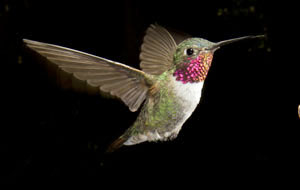
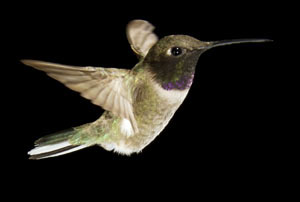
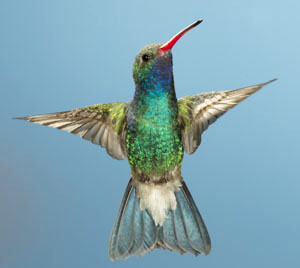
For our five flash setups we use natural-looking photo backgrounds, like that behind the Broad-billed Hummingbird. However, for my own, very limited shooting, I did a lot of PhotoTrap work (the setup I then used on the leaf-nosed bats) where the background was natural
and, consequently, black. Hummers do not fly at night, which is why we avoid using them, but here I liked the effect, and my own portfolio was very limited anyway!
 The Canyon, in contrast to last year, was quite dry. Two years ago, the stream that runs behind our cabins was low and I was able to dam up a little pool for photographing bats in the canyon. Last year that same stream had transformed itself into a full-fledged creek, and bats and birds had virtually anywhere along the stream to drink. With this year's dry conditions the stream bed was almost devoid of water within working distance of our lodge, making bat photography there impossible. But our water set, which enjoys great activity every year, was extremely productive this year, with extremely tame Rufous-crowned Sparrows, numerous Black-headed Grosbeaks, and, at the oranges we place nearby, Hepatic, Summer, and Western Tanagers.
The Canyon, in contrast to last year, was quite dry. Two years ago, the stream that runs behind our cabins was low and I was able to dam up a little pool for photographing bats in the canyon. Last year that same stream had transformed itself into a full-fledged creek, and bats and birds had virtually anywhere along the stream to drink. With this year's dry conditions the stream bed was almost devoid of water within working distance of our lodge, making bat photography there impossible. But our water set, which enjoys great activity every year, was extremely productive this year, with extremely tame Rufous-crowned Sparrows, numerous Black-headed Grosbeaks, and, at the oranges we place nearby, Hepatic, Summer, and Western Tanagers.
Because of this drought flowering plants were rare within the canyon and our hummingbird feeders almost immediately saw action. Our Five High-Speed Flash Photography sets were always active, and it was rare when any feeder didn't see action. The shooting was great!
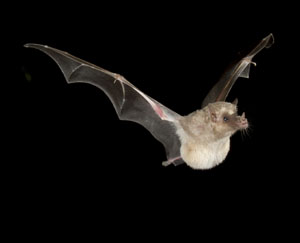 Our schedule this year -- as it will again next year -- coincided with the appearance of the nectar-feeling Lesser Leaf-nosed Bats which visited one of my hummingbird feeder sets where I did some unmanned PhotoTrap work while the group and I photographed four or five different species of BATS at my friend Bill Forbes' Pond.
Our schedule this year -- as it will again next year -- coincided with the appearance of the nectar-feeling Lesser Leaf-nosed Bats which visited one of my hummingbird feeder sets where I did some unmanned PhotoTrap work while the group and I photographed four or five different species of BATS at my friend Bill Forbes' Pond.
Four days of full-time shooting with song birds at first light in the canyon, then our rotations through our five hummingbird sets, followed by the drive down to the Pond where we set up for bats and shot, or waited, until 10PM made for very full days. In my spare time, I set up another PhotoTrap at our table-top pond where a Gray Fox and a Hooded Skunk visited for drinks during the last few days of our time in Arizona. We were hoping to have our participants set up for the fox but that animal's schedule was not predictable -- sometimes it'd come to drink at 8PM, sometimes at 3AM! The PhotoTrap captured images for me, but I'd have loved to had other shooters behind their cameras firing when the PT tripped my camera and flashes. Time intruded -- there was just too much other things to shoot!
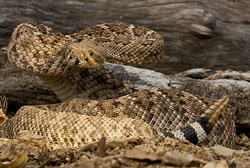 Which included one of the largest Western Diamondback Rattlesnakes I've ever collected in Arizona. The snake was approximately four feet long but fortunately it stayed in position when placed on the eye-level set I made, and groups two and three got some very nice shots.
Which included one of the largest Western Diamondback Rattlesnakes I've ever collected in Arizona. The snake was approximately four feet long but fortunately it stayed in position when placed on the eye-level set I made, and groups two and three got some very nice shots.
Bat photography is a real challenge and virtually all of my free time was involved in solving the puzzle posed by the bats to make a great image. The challenges include the wind -- if it is blowing hard the bats fly somewhat erratically, and if it is blowing from the east the bats fly facing away from our cameras. If it is cold the bat activity is suppressed, and if it is cold and windy conditions are too poor for shooting.
Because of this we had three shoots per group, with one or two of those days yielding successful images. During the day I spent hours analyzing the bats flight paths so that on our subsequent nights we could fine-tune our compositions and framing, going for tighter shots. Wider views captured most of the bats that visited the pond, and cropping those images yielded spectacular shots but I wanted the group to get frame-filling, or nearly so, shots of the bats without cropping and that, believe me, was a lot of work. Hours worth each day.
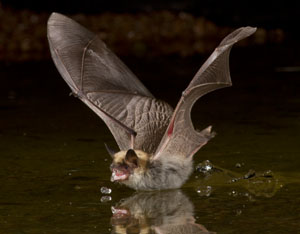
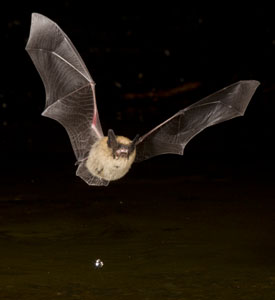
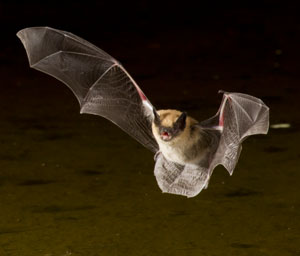
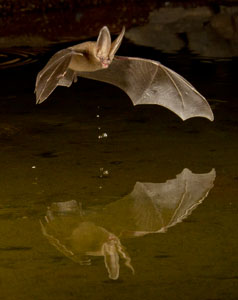
I think I succeeded in working out the bat photography puzzle which I will implement again next year when we will once again offer our Hummingbird and Bat Photography High Speed Flash Photo Shoot.
All of our shoots included one morning at 'The Pond' where participants shots as many as 25 species of birds in a morning. Mary and I did not get the chance to shoot this year, but our groups did very well.. Some of the highlights from 'The Pond' included Western Tanagers, Hooded Oriole, baby Gambel's Quail, Roadrunners, several different species of Warbler, and several different Sparrows, plus the striking Pyrrhuloxia and its close relative, the Northern Cardinal.
 Special thanks must go to Bill and Lynn Forbes from 'The Pond,' for the wonderful hospitality and incredible shooting opportunities, and Manfrotto for their support with much of the equipment I was using. Regarding that, each of our five hummingbird sets had 4 Articulating Arms, 1 Flex Arm, and 5 Super Clamps, and our Bat shoots had at least 4 Variable-Friction Magic Arms and Base Plates for Arms. My Gray Fox water set included at least four Magic Arms, 8 Super Clamps, and two 13 foot Lightstands. In other places, at other times I had multiple other set-ups going, so in all I often had nearly 50 Articulating Arms, Lightstands, SuperClamps, and other accessories. We're also using 20 flashes for the five sets and 4 flashes for the bats at the Pond and four for the nectar-feeding bats. In total, I had three PhotoTraps in operation for this shoot - at the Pond, at my water set, and at the nectar-feeding bat setup. . When we pack up our truck to travel to and from Arizona the 8 foot bed, capped, is filled to capacity, with barely a cubic yard of space left over! See our Tip of the Month for a more detailed description of how to use some of these Manfrotto products.
Special thanks must go to Bill and Lynn Forbes from 'The Pond,' for the wonderful hospitality and incredible shooting opportunities, and Manfrotto for their support with much of the equipment I was using. Regarding that, each of our five hummingbird sets had 4 Articulating Arms, 1 Flex Arm, and 5 Super Clamps, and our Bat shoots had at least 4 Variable-Friction Magic Arms and Base Plates for Arms. My Gray Fox water set included at least four Magic Arms, 8 Super Clamps, and two 13 foot Lightstands. In other places, at other times I had multiple other set-ups going, so in all I often had nearly 50 Articulating Arms, Lightstands, SuperClamps, and other accessories. We're also using 20 flashes for the five sets and 4 flashes for the bats at the Pond and four for the nectar-feeding bats. In total, I had three PhotoTraps in operation for this shoot - at the Pond, at my water set, and at the nectar-feeding bat setup. . When we pack up our truck to travel to and from Arizona the 8 foot bed, capped, is filled to capacity, with barely a cubic yard of space left over! See our Tip of the Month for a more detailed description of how to use some of these Manfrotto products.
 Our natural light set ups worked very well this year and, as usual, I planted several dead trees around to create nice perches for the Acorn Woodpeckers, Mexican Jays, and other birds that hit the feeders. Still, at our natural light set-ups at the 'dead tree forest' and our table-top pond, we had a variety of species, including Mexican Yellow-eyed Juncos, Bewick's Wren, Bridled Titmouse, White-breasted Nuthatch, Black-headed Grosbeak, Scott's Oriole, Acorn Woodpecker, Arizona Woodpecker, Lesser Goldfinch, Pine Siskin, Rufous-crowned Sparrow, and Hepatic Tanager.
Our natural light set ups worked very well this year and, as usual, I planted several dead trees around to create nice perches for the Acorn Woodpeckers, Mexican Jays, and other birds that hit the feeders. Still, at our natural light set-ups at the 'dead tree forest' and our table-top pond, we had a variety of species, including Mexican Yellow-eyed Juncos, Bewick's Wren, Bridled Titmouse, White-breasted Nuthatch, Black-headed Grosbeak, Scott's Oriole, Acorn Woodpecker, Arizona Woodpecker, Lesser Goldfinch, Pine Siskin, Rufous-crowned Sparrow, and Hepatic Tanager.
Bats of Arizona
Please note that the Bat portfolio represents work from 2009 and 2010,
and not just from this year's shoot. In 2009 we had the opportunity to
shoot at three locations - The Pond, and the stream behind our lodge,
and one of our hummingbird sets for long-nosed bats. In a typical year
we should have the opportunity to film at all three locations, but in the
unusual cold of 2010 that did not happen!
Check out our 2009 and 2010 Bat Portfolio
Read our 2009 Trip Report and 2010 Trip Report for further information!
About Your Leaders
Contact our Office to REGISTER for our 20121 Hummingbird and Hummingbird and Bat Photo Shoots
Contact us by e-mail at
info@hoothollow.com
Office Phone: 717 543-6423
Or FAX us at: (717) 543-5342.
Return to HomePage or to photo tours general information.
Hummingbirds and Bats
of Southern Arizona
TRIP REPORT, 2011




This year marked our 20th year of offering our Hummingbird High Speed Flash Photo Tour which was incorporated with our first full season of nocturnal Bat photography.
Because of the India Tiger Photo Safaris, we didn't arrive back in to the US until late April, we could only fit in three photo shoots spanning May 8th through May 23rd, which we compressed into back-to-back programs that gave Mary and me very little free time. Consequently, neither of us did very much photographing of hummingbirds, and with our files well-stocked with great images we were not too upset by this. Still, during those three shoots we had Magnificent, Broad-billed, Broad-tailed, Anna's, and Black-chinned Hummingbirds. Field guide identification can be challenging for females, and some images I made with a PhotoTrap are, I believe, of a Blue-throated Hummingbird female. If so, that's 6 different species -- a great diversity for one canyon!



For our five flash setups we use natural-looking photo backgrounds, like that behind the Broad-billed Hummingbird. However, for my own, very limited shooting, I did a lot of PhotoTrap work (the setup I then used on the leaf-nosed bats) where the background was natural
and, consequently, black. Hummers do not fly at night, which is why we avoid using them, but here I liked the effect, and my own portfolio was very limited anyway!
 The Canyon, in contrast to last year, was quite dry. Two years ago, the stream that runs behind our cabins was low and I was able to dam up a little pool for photographing bats in the canyon. Last year that same stream had transformed itself into a full-fledged creek, and bats and birds had virtually anywhere along the stream to drink. With this year's dry conditions the stream bed was almost devoid of water within working distance of our lodge, making bat photography there impossible. But our water set, which enjoys great activity every year, was extremely productive this year, with extremely tame Rufous-crowned Sparrows, numerous Black-headed Grosbeaks, and, at the oranges we place nearby, Hepatic, Summer, and Western Tanagers.
The Canyon, in contrast to last year, was quite dry. Two years ago, the stream that runs behind our cabins was low and I was able to dam up a little pool for photographing bats in the canyon. Last year that same stream had transformed itself into a full-fledged creek, and bats and birds had virtually anywhere along the stream to drink. With this year's dry conditions the stream bed was almost devoid of water within working distance of our lodge, making bat photography there impossible. But our water set, which enjoys great activity every year, was extremely productive this year, with extremely tame Rufous-crowned Sparrows, numerous Black-headed Grosbeaks, and, at the oranges we place nearby, Hepatic, Summer, and Western Tanagers.
Because of this drought flowering plants were rare within the canyon and our hummingbird feeders almost immediately saw action. Our Five High-Speed Flash Photography sets were always active, and it was rare when any feeder didn't see action. The shooting was great!
 Our schedule this year -- as it will again next year -- coincided with the appearance of the nectar-feeling Lesser Leaf-nosed Bats which visited one of my hummingbird feeder sets where I did some unmanned PhotoTrap work while the group and I photographed four or five different species of BATS at my friend Bill Forbes' Pond.
Our schedule this year -- as it will again next year -- coincided with the appearance of the nectar-feeling Lesser Leaf-nosed Bats which visited one of my hummingbird feeder sets where I did some unmanned PhotoTrap work while the group and I photographed four or five different species of BATS at my friend Bill Forbes' Pond.
Four days of full-time shooting with song birds at first light in the canyon, then our rotations through our five hummingbird sets, followed by the drive down to the Pond where we set up for bats and shot, or waited, until 10PM made for very full days. In my spare time, I set up another PhotoTrap at our table-top pond where a Gray Fox and a Hooded Skunk visited for drinks during the last few days of our time in Arizona. We were hoping to have our participants set up for the fox but that animal's schedule was not predictable -- sometimes it'd come to drink at 8PM, sometimes at 3AM! The PhotoTrap captured images for me, but I'd have loved to had other shooters behind their cameras firing when the PT tripped my camera and flashes. Time intruded -- there was just too much other things to shoot!
 Which included one of the largest Western Diamondback Rattlesnakes I've ever collected in Arizona. The snake was approximately four feet long but fortunately it stayed in position when placed on the eye-level set I made, and groups two and three got some very nice shots.
Which included one of the largest Western Diamondback Rattlesnakes I've ever collected in Arizona. The snake was approximately four feet long but fortunately it stayed in position when placed on the eye-level set I made, and groups two and three got some very nice shots.
Bat photography is a real challenge and virtually all of my free time was involved in solving the puzzle posed by the bats to make a great image. The challenges include the wind -- if it is blowing hard the bats fly somewhat erratically, and if it is blowing from the east the bats fly facing away from our cameras. If it is cold the bat activity is suppressed, and if it is cold and windy conditions are too poor for shooting.
Because of this we had three shoots per group, with one or two of those days yielding successful images. During the day I spent hours analyzing the bats flight paths so that on our subsequent nights we could fine-tune our compositions and framing, going for tighter shots. Wider views captured most of the bats that visited the pond, and cropping those images yielded spectacular shots but I wanted the group to get frame-filling, or nearly so, shots of the bats without cropping and that, believe me, was a lot of work. Hours worth each day.




I think I succeeded in working out the bat photography puzzle which I will implement again next year when we will once again offer our Hummingbird and Bat Photography High Speed Flash Photo Shoot.
All of our shoots included one morning at 'The Pond' where participants shots as many as 25 species of birds in a morning. Mary and I did not get the chance to shoot this year, but our groups did very well.. Some of the highlights from 'The Pond' included Western Tanagers, Hooded Oriole, baby Gambel's Quail, Roadrunners, several different species of Warbler, and several different Sparrows, plus the striking Pyrrhuloxia and its close relative, the Northern Cardinal.
 Special thanks must go to Bill and Lynn Forbes from 'The Pond,' for the wonderful hospitality and incredible shooting opportunities, and Manfrotto for their support with much of the equipment I was using. Regarding that, each of our five hummingbird sets had 4 Articulating Arms, 1 Flex Arm, and 5 Super Clamps, and our Bat shoots had at least 4 Variable-Friction Magic Arms and Base Plates for Arms. My Gray Fox water set included at least four Magic Arms, 8 Super Clamps, and two 13 foot Lightstands. In other places, at other times I had multiple other set-ups going, so in all I often had nearly 50 Articulating Arms, Lightstands, SuperClamps, and other accessories. We're also using 20 flashes for the five sets and 4 flashes for the bats at the Pond and four for the nectar-feeding bats. In total, I had three PhotoTraps in operation for this shoot - at the Pond, at my water set, and at the nectar-feeding bat setup. . When we pack up our truck to travel to and from Arizona the 8 foot bed, capped, is filled to capacity, with barely a cubic yard of space left over! See our Tip of the Month for a more detailed description of how to use some of these Manfrotto products.
Special thanks must go to Bill and Lynn Forbes from 'The Pond,' for the wonderful hospitality and incredible shooting opportunities, and Manfrotto for their support with much of the equipment I was using. Regarding that, each of our five hummingbird sets had 4 Articulating Arms, 1 Flex Arm, and 5 Super Clamps, and our Bat shoots had at least 4 Variable-Friction Magic Arms and Base Plates for Arms. My Gray Fox water set included at least four Magic Arms, 8 Super Clamps, and two 13 foot Lightstands. In other places, at other times I had multiple other set-ups going, so in all I often had nearly 50 Articulating Arms, Lightstands, SuperClamps, and other accessories. We're also using 20 flashes for the five sets and 4 flashes for the bats at the Pond and four for the nectar-feeding bats. In total, I had three PhotoTraps in operation for this shoot - at the Pond, at my water set, and at the nectar-feeding bat setup. . When we pack up our truck to travel to and from Arizona the 8 foot bed, capped, is filled to capacity, with barely a cubic yard of space left over! See our Tip of the Month for a more detailed description of how to use some of these Manfrotto products.
 Our natural light set ups worked very well this year and, as usual, I planted several dead trees around to create nice perches for the Acorn Woodpeckers, Mexican Jays, and other birds that hit the feeders. Still, at our natural light set-ups at the 'dead tree forest' and our table-top pond, we had a variety of species, including Mexican Yellow-eyed Juncos, Bewick's Wren, Bridled Titmouse, White-breasted Nuthatch, Black-headed Grosbeak, Scott's Oriole, Acorn Woodpecker, Arizona Woodpecker, Lesser Goldfinch, Pine Siskin, Rufous-crowned Sparrow, and Hepatic Tanager.
Our natural light set ups worked very well this year and, as usual, I planted several dead trees around to create nice perches for the Acorn Woodpeckers, Mexican Jays, and other birds that hit the feeders. Still, at our natural light set-ups at the 'dead tree forest' and our table-top pond, we had a variety of species, including Mexican Yellow-eyed Juncos, Bewick's Wren, Bridled Titmouse, White-breasted Nuthatch, Black-headed Grosbeak, Scott's Oriole, Acorn Woodpecker, Arizona Woodpecker, Lesser Goldfinch, Pine Siskin, Rufous-crowned Sparrow, and Hepatic Tanager.
Bats of Arizona
Please note that the Bat portfolio represents work from 2009 and 2010,
and not just from this year's shoot. In 2009 we had the opportunity to
shoot at three locations - The Pond, and the stream behind our lodge,
and one of our hummingbird sets for long-nosed bats. In a typical year
we should have the opportunity to film at all three locations, but in the
unusual cold of 2010 that did not happen!
Check out our 2009 and 2010 Bat Portfolio
Read our 2009 Trip Report and 2010 Trip Report for further information!
About Your Leaders
Contact our Office to REGISTER for our 20121 Hummingbird and Hummingbird and Bat Photo Shoots
Contact us by e-mail at
info@hoothollow.com
Office Phone: 717 543-6423
Or FAX us at: (717) 543-5342.
Return to HomePage or to photo tours general information.
Hummingbirds and Bats
of Southern Arizona
TRIP REPORT, 2011




This year marked our 20th year of offering our Hummingbird High Speed Flash Photo Tour which was incorporated with our first full season of nocturnal Bat photography.
Because of the India Tiger Photo Safaris, we didn't arrive back in to the US until late April, we could only fit in three photo shoots spanning May 8th through May 23rd, which we compressed into back-to-back programs that gave Mary and me very little free time. Consequently, neither of us did very much photographing of hummingbirds, and with our files well-stocked with great images we were not too upset by this. Still, during those three shoots we had Magnificent, Broad-billed, Broad-tailed, Anna's, and Black-chinned Hummingbirds. Field guide identification can be challenging for females, and some images I made with a PhotoTrap are, I believe, of a Blue-throated Hummingbird female. If so, that's 6 different species -- a great diversity for one canyon!



For our five flash setups we use natural-looking photo backgrounds, like that behind the Broad-billed Hummingbird. However, for my own, very limited shooting, I did a lot of PhotoTrap work (the setup I then used on the leaf-nosed bats) where the background was natural
and, consequently, black. Hummers do not fly at night, which is why we avoid using them, but here I liked the effect, and my own portfolio was very limited anyway!
 The Canyon, in contrast to last year, was quite dry. Two years ago, the stream that runs behind our cabins was low and I was able to dam up a little pool for photographing bats in the canyon. Last year that same stream had transformed itself into a full-fledged creek, and bats and birds had virtually anywhere along the stream to drink. With this year's dry conditions the stream bed was almost devoid of water within working distance of our lodge, making bat photography there impossible. But our water set, which enjoys great activity every year, was extremely productive this year, with extremely tame Rufous-crowned Sparrows, numerous Black-headed Grosbeaks, and, at the oranges we place nearby, Hepatic, Summer, and Western Tanagers.
The Canyon, in contrast to last year, was quite dry. Two years ago, the stream that runs behind our cabins was low and I was able to dam up a little pool for photographing bats in the canyon. Last year that same stream had transformed itself into a full-fledged creek, and bats and birds had virtually anywhere along the stream to drink. With this year's dry conditions the stream bed was almost devoid of water within working distance of our lodge, making bat photography there impossible. But our water set, which enjoys great activity every year, was extremely productive this year, with extremely tame Rufous-crowned Sparrows, numerous Black-headed Grosbeaks, and, at the oranges we place nearby, Hepatic, Summer, and Western Tanagers.
Because of this drought flowering plants were rare within the canyon and our hummingbird feeders almost immediately saw action. Our Five High-Speed Flash Photography sets were always active, and it was rare when any feeder didn't see action. The shooting was great!
 Our schedule this year -- as it will again next year -- coincided with the appearance of the nectar-feeling Lesser Leaf-nosed Bats which visited one of my hummingbird feeder sets where I did some unmanned PhotoTrap work while the group and I photographed four or five different species of BATS at my friend Bill Forbes' Pond.
Our schedule this year -- as it will again next year -- coincided with the appearance of the nectar-feeling Lesser Leaf-nosed Bats which visited one of my hummingbird feeder sets where I did some unmanned PhotoTrap work while the group and I photographed four or five different species of BATS at my friend Bill Forbes' Pond.
Four days of full-time shooting with song birds at first light in the canyon, then our rotations through our five hummingbird sets, followed by the drive down to the Pond where we set up for bats and shot, or waited, until 10PM made for very full days. In my spare time, I set up another PhotoTrap at our table-top pond where a Gray Fox and a Hooded Skunk visited for drinks during the last few days of our time in Arizona. We were hoping to have our participants set up for the fox but that animal's schedule was not predictable -- sometimes it'd come to drink at 8PM, sometimes at 3AM! The PhotoTrap captured images for me, but I'd have loved to had other shooters behind their cameras firing when the PT tripped my camera and flashes. Time intruded -- there was just too much other things to shoot!
 Which included one of the largest Western Diamondback Rattlesnakes I've ever collected in Arizona. The snake was approximately four feet long but fortunately it stayed in position when placed on the eye-level set I made, and groups two and three got some very nice shots.
Which included one of the largest Western Diamondback Rattlesnakes I've ever collected in Arizona. The snake was approximately four feet long but fortunately it stayed in position when placed on the eye-level set I made, and groups two and three got some very nice shots.
Bat photography is a real challenge and virtually all of my free time was involved in solving the puzzle posed by the bats to make a great image. The challenges include the wind -- if it is blowing hard the bats fly somewhat erratically, and if it is blowing from the east the bats fly facing away from our cameras. If it is cold the bat activity is suppressed, and if it is cold and windy conditions are too poor for shooting.
Because of this we had three shoots per group, with one or two of those days yielding successful images. During the day I spent hours analyzing the bats flight paths so that on our subsequent nights we could fine-tune our compositions and framing, going for tighter shots. Wider views captured most of the bats that visited the pond, and cropping those images yielded spectacular shots but I wanted the group to get frame-filling, or nearly so, shots of the bats without cropping and that, believe me, was a lot of work. Hours worth each day.




I think I succeeded in working out the bat photography puzzle which I will implement again next year when we will once again offer our Hummingbird and Bat Photography High Speed Flash Photo Shoot.
All of our shoots included one morning at 'The Pond' where participants shots as many as 25 species of birds in a morning. Mary and I did not get the chance to shoot this year, but our groups did very well.. Some of the highlights from 'The Pond' included Western Tanagers, Hooded Oriole, baby Gambel's Quail, Roadrunners, several different species of Warbler, and several different Sparrows, plus the striking Pyrrhuloxia and its close relative, the Northern Cardinal.
 Special thanks must go to Bill and Lynn Forbes from 'The Pond,' for the wonderful hospitality and incredible shooting opportunities, and Manfrotto for their support with much of the equipment I was using. Regarding that, each of our five hummingbird sets had 4 Articulating Arms, 1 Flex Arm, and 5 Super Clamps, and our Bat shoots had at least 4 Variable-Friction Magic Arms and Base Plates for Arms. My Gray Fox water set included at least four Magic Arms, 8 Super Clamps, and two 13 foot Lightstands. In other places, at other times I had multiple other set-ups going, so in all I often had nearly 50 Articulating Arms, Lightstands, SuperClamps, and other accessories. We're also using 20 flashes for the five sets and 4 flashes for the bats at the Pond and four for the nectar-feeding bats. In total, I had three PhotoTraps in operation for this shoot - at the Pond, at my water set, and at the nectar-feeding bat setup. . When we pack up our truck to travel to and from Arizona the 8 foot bed, capped, is filled to capacity, with barely a cubic yard of space left over! See our Tip of the Month for a more detailed description of how to use some of these Manfrotto products.
Special thanks must go to Bill and Lynn Forbes from 'The Pond,' for the wonderful hospitality and incredible shooting opportunities, and Manfrotto for their support with much of the equipment I was using. Regarding that, each of our five hummingbird sets had 4 Articulating Arms, 1 Flex Arm, and 5 Super Clamps, and our Bat shoots had at least 4 Variable-Friction Magic Arms and Base Plates for Arms. My Gray Fox water set included at least four Magic Arms, 8 Super Clamps, and two 13 foot Lightstands. In other places, at other times I had multiple other set-ups going, so in all I often had nearly 50 Articulating Arms, Lightstands, SuperClamps, and other accessories. We're also using 20 flashes for the five sets and 4 flashes for the bats at the Pond and four for the nectar-feeding bats. In total, I had three PhotoTraps in operation for this shoot - at the Pond, at my water set, and at the nectar-feeding bat setup. . When we pack up our truck to travel to and from Arizona the 8 foot bed, capped, is filled to capacity, with barely a cubic yard of space left over! See our Tip of the Month for a more detailed description of how to use some of these Manfrotto products.
 Our natural light set ups worked very well this year and, as usual, I planted several dead trees around to create nice perches for the Acorn Woodpeckers, Mexican Jays, and other birds that hit the feeders. Still, at our natural light set-ups at the 'dead tree forest' and our table-top pond, we had a variety of species, including Mexican Yellow-eyed Juncos, Bewick's Wren, Bridled Titmouse, White-breasted Nuthatch, Black-headed Grosbeak, Scott's Oriole, Acorn Woodpecker, Arizona Woodpecker, Lesser Goldfinch, Pine Siskin, Rufous-crowned Sparrow, and Hepatic Tanager.
Our natural light set ups worked very well this year and, as usual, I planted several dead trees around to create nice perches for the Acorn Woodpeckers, Mexican Jays, and other birds that hit the feeders. Still, at our natural light set-ups at the 'dead tree forest' and our table-top pond, we had a variety of species, including Mexican Yellow-eyed Juncos, Bewick's Wren, Bridled Titmouse, White-breasted Nuthatch, Black-headed Grosbeak, Scott's Oriole, Acorn Woodpecker, Arizona Woodpecker, Lesser Goldfinch, Pine Siskin, Rufous-crowned Sparrow, and Hepatic Tanager.
Bats of Arizona
Please note that the Bat portfolio represents work from 2009 and 2010,
and not just from this year's shoot. In 2009 we had the opportunity to
shoot at three locations - The Pond, and the stream behind our lodge,
and one of our hummingbird sets for long-nosed bats. In a typical year
we should have the opportunity to film at all three locations, but in the
unusual cold of 2010 that did not happen!
Check out our 2009 and 2010 Bat Portfolio
Read our 2009 Trip Report and 2010 Trip Report for further information!
About Your Leaders
Contact our Office to REGISTER for our 20121 Hummingbird and Hummingbird and Bat Photo Shoots
Contact us by e-mail at
info@hoothollow.com
Office Phone: 717 543-6423
Or FAX us at: (717) 543-5342.
Return to HomePage or to photo tours general information.
Hummingbirds and Bats
of Southern Arizona
TRIP REPORT, 2011




This year marked our 20th year of offering our Hummingbird High Speed Flash Photo Tour which was incorporated with our first full season of nocturnal Bat photography.
Because of the India Tiger Photo Safaris, we didn't arrive back in to the US until late April, we could only fit in three photo shoots spanning May 8th through May 23rd, which we compressed into back-to-back programs that gave Mary and me very little free time. Consequently, neither of us did very much photographing of hummingbirds, and with our files well-stocked with great images we were not too upset by this. Still, during those three shoots we had Magnificent, Broad-billed, Broad-tailed, Anna's, and Black-chinned Hummingbirds. Field guide identification can be challenging for females, and some images I made with a PhotoTrap are, I believe, of a Blue-throated Hummingbird female. If so, that's 6 different species -- a great diversity for one canyon!



For our five flash setups we use natural-looking photo backgrounds, like that behind the Broad-billed Hummingbird. However, for my own, very limited shooting, I did a lot of PhotoTrap work (the setup I then used on the leaf-nosed bats) where the background was natural
and, consequently, black. Hummers do not fly at night, which is why we avoid using them, but here I liked the effect, and my own portfolio was very limited anyway!
 The Canyon, in contrast to last year, was quite dry. Two years ago, the stream that runs behind our cabins was low and I was able to dam up a little pool for photographing bats in the canyon. Last year that same stream had transformed itself into a full-fledged creek, and bats and birds had virtually anywhere along the stream to drink. With this year's dry conditions the stream bed was almost devoid of water within working distance of our lodge, making bat photography there impossible. But our water set, which enjoys great activity every year, was extremely productive this year, with extremely tame Rufous-crowned Sparrows, numerous Black-headed Grosbeaks, and, at the oranges we place nearby, Hepatic, Summer, and Western Tanagers.
The Canyon, in contrast to last year, was quite dry. Two years ago, the stream that runs behind our cabins was low and I was able to dam up a little pool for photographing bats in the canyon. Last year that same stream had transformed itself into a full-fledged creek, and bats and birds had virtually anywhere along the stream to drink. With this year's dry conditions the stream bed was almost devoid of water within working distance of our lodge, making bat photography there impossible. But our water set, which enjoys great activity every year, was extremely productive this year, with extremely tame Rufous-crowned Sparrows, numerous Black-headed Grosbeaks, and, at the oranges we place nearby, Hepatic, Summer, and Western Tanagers.
Because of this drought flowering plants were rare within the canyon and our hummingbird feeders almost immediately saw action. Our Five High-Speed Flash Photography sets were always active, and it was rare when any feeder didn't see action. The shooting was great!
 Our schedule this year -- as it will again next year -- coincided with the appearance of the nectar-feeling Lesser Leaf-nosed Bats which visited one of my hummingbird feeder sets where I did some unmanned PhotoTrap work while the group and I photographed four or five different species of BATS at my friend Bill Forbes' Pond.
Our schedule this year -- as it will again next year -- coincided with the appearance of the nectar-feeling Lesser Leaf-nosed Bats which visited one of my hummingbird feeder sets where I did some unmanned PhotoTrap work while the group and I photographed four or five different species of BATS at my friend Bill Forbes' Pond.
Four days of full-time shooting with song birds at first light in the canyon, then our rotations through our five hummingbird sets, followed by the drive down to the Pond where we set up for bats and shot, or waited, until 10PM made for very full days. In my spare time, I set up another PhotoTrap at our table-top pond where a Gray Fox and a Hooded Skunk visited for drinks during the last few days of our time in Arizona. We were hoping to have our participants set up for the fox but that animal's schedule was not predictable -- sometimes it'd come to drink at 8PM, sometimes at 3AM! The PhotoTrap captured images for me, but I'd have loved to had other shooters behind their cameras firing when the PT tripped my camera and flashes. Time intruded -- there was just too much other things to shoot!
 Which included one of the largest Western Diamondback Rattlesnakes I've ever collected in Arizona. The snake was approximately four feet long but fortunately it stayed in position when placed on the eye-level set I made, and groups two and three got some very nice shots.
Which included one of the largest Western Diamondback Rattlesnakes I've ever collected in Arizona. The snake was approximately four feet long but fortunately it stayed in position when placed on the eye-level set I made, and groups two and three got some very nice shots.
Bat photography is a real challenge and virtually all of my free time was involved in solving the puzzle posed by the bats to make a great image. The challenges include the wind -- if it is blowing hard the bats fly somewhat erratically, and if it is blowing from the east the bats fly facing away from our cameras. If it is cold the bat activity is suppressed, and if it is cold and windy conditions are too poor for shooting.
Because of this we had three shoots per group, with one or two of those days yielding successful images. During the day I spent hours analyzing the bats flight paths so that on our subsequent nights we could fine-tune our compositions and framing, going for tighter shots. Wider views captured most of the bats that visited the pond, and cropping those images yielded spectacular shots but I wanted the group to get frame-filling, or nearly so, shots of the bats without cropping and that, believe me, was a lot of work. Hours worth each day.




I think I succeeded in working out the bat photography puzzle which I will implement again next year when we will once again offer our Hummingbird and Bat Photography High Speed Flash Photo Shoot.
All of our shoots included one morning at 'The Pond' where participants shots as many as 25 species of birds in a morning. Mary and I did not get the chance to shoot this year, but our groups did very well.. Some of the highlights from 'The Pond' included Western Tanagers, Hooded Oriole, baby Gambel's Quail, Roadrunners, several different species of Warbler, and several different Sparrows, plus the striking Pyrrhuloxia and its close relative, the Northern Cardinal.
 Special thanks must go to Bill and Lynn Forbes from 'The Pond,' for the wonderful hospitality and incredible shooting opportunities, and Manfrotto for their support with much of the equipment I was using. Regarding that, each of our five hummingbird sets had 4 Articulating Arms, 1 Flex Arm, and 5 Super Clamps, and our Bat shoots had at least 4 Variable-Friction Magic Arms and Base Plates for Arms. My Gray Fox water set included at least four Magic Arms, 8 Super Clamps, and two 13 foot Lightstands. In other places, at other times I had multiple other set-ups going, so in all I often had nearly 50 Articulating Arms, Lightstands, SuperClamps, and other accessories. We're also using 20 flashes for the five sets and 4 flashes for the bats at the Pond and four for the nectar-feeding bats. In total, I had three PhotoTraps in operation for this shoot - at the Pond, at my water set, and at the nectar-feeding bat setup. . When we pack up our truck to travel to and from Arizona the 8 foot bed, capped, is filled to capacity, with barely a cubic yard of space left over! See our Tip of the Month for a more detailed description of how to use some of these Manfrotto products.
Special thanks must go to Bill and Lynn Forbes from 'The Pond,' for the wonderful hospitality and incredible shooting opportunities, and Manfrotto for their support with much of the equipment I was using. Regarding that, each of our five hummingbird sets had 4 Articulating Arms, 1 Flex Arm, and 5 Super Clamps, and our Bat shoots had at least 4 Variable-Friction Magic Arms and Base Plates for Arms. My Gray Fox water set included at least four Magic Arms, 8 Super Clamps, and two 13 foot Lightstands. In other places, at other times I had multiple other set-ups going, so in all I often had nearly 50 Articulating Arms, Lightstands, SuperClamps, and other accessories. We're also using 20 flashes for the five sets and 4 flashes for the bats at the Pond and four for the nectar-feeding bats. In total, I had three PhotoTraps in operation for this shoot - at the Pond, at my water set, and at the nectar-feeding bat setup. . When we pack up our truck to travel to and from Arizona the 8 foot bed, capped, is filled to capacity, with barely a cubic yard of space left over! See our Tip of the Month for a more detailed description of how to use some of these Manfrotto products.
 Our natural light set ups worked very well this year and, as usual, I planted several dead trees around to create nice perches for the Acorn Woodpeckers, Mexican Jays, and other birds that hit the feeders. Still, at our natural light set-ups at the 'dead tree forest' and our table-top pond, we had a variety of species, including Mexican Yellow-eyed Juncos, Bewick's Wren, Bridled Titmouse, White-breasted Nuthatch, Black-headed Grosbeak, Scott's Oriole, Acorn Woodpecker, Arizona Woodpecker, Lesser Goldfinch, Pine Siskin, Rufous-crowned Sparrow, and Hepatic Tanager.
Our natural light set ups worked very well this year and, as usual, I planted several dead trees around to create nice perches for the Acorn Woodpeckers, Mexican Jays, and other birds that hit the feeders. Still, at our natural light set-ups at the 'dead tree forest' and our table-top pond, we had a variety of species, including Mexican Yellow-eyed Juncos, Bewick's Wren, Bridled Titmouse, White-breasted Nuthatch, Black-headed Grosbeak, Scott's Oriole, Acorn Woodpecker, Arizona Woodpecker, Lesser Goldfinch, Pine Siskin, Rufous-crowned Sparrow, and Hepatic Tanager.
Bats of Arizona
Please note that the Bat portfolio represents work from 2009 and 2010,
and not just from this year's shoot. In 2009 we had the opportunity to
shoot at three locations - The Pond, and the stream behind our lodge,
and one of our hummingbird sets for long-nosed bats. In a typical year
we should have the opportunity to film at all three locations, but in the
unusual cold of 2010 that did not happen!
Check out our 2009 and 2010 Bat Portfolio
Read our 2009 Trip Report and 2010 Trip Report for further information!
About Your Leaders
Contact our Office to REGISTER for our 20121 Hummingbird and Hummingbird and Bat Photo Shoots
Contact us by e-mail at
info@hoothollow.com
Office Phone: 717 543-6423
Or FAX us at: (717) 543-5342.
Return to HomePage or to photo tours general information.
Hummingbirds and Bats
of Southern Arizona
TRIP REPORT, 2011




This year marked our 20th year of offering our Hummingbird High Speed Flash Photo Tour which was incorporated with our first full season of nocturnal Bat photography.
Because of the India Tiger Photo Safaris, we didn't arrive back in to the US until late April, we could only fit in three photo shoots spanning May 8th through May 23rd, which we compressed into back-to-back programs that gave Mary and me very little free time. Consequently, neither of us did very much photographing of hummingbirds, and with our files well-stocked with great images we were not too upset by this. Still, during those three shoots we had Magnificent, Broad-billed, Broad-tailed, Anna's, and Black-chinned Hummingbirds. Field guide identification can be challenging for females, and some images I made with a PhotoTrap are, I believe, of a Blue-throated Hummingbird female. If so, that's 6 different species -- a great diversity for one canyon!



For our five flash setups we use natural-looking photo backgrounds, like that behind the Broad-billed Hummingbird. However, for my own, very limited shooting, I did a lot of PhotoTrap work (the setup I then used on the leaf-nosed bats) where the background was natural
and, consequently, black. Hummers do not fly at night, which is why we avoid using them, but here I liked the effect, and my own portfolio was very limited anyway!
 The Canyon, in contrast to last year, was quite dry. Two years ago, the stream that runs behind our cabins was low and I was able to dam up a little pool for photographing bats in the canyon. Last year that same stream had transformed itself into a full-fledged creek, and bats and birds had virtually anywhere along the stream to drink. With this year's dry conditions the stream bed was almost devoid of water within working distance of our lodge, making bat photography there impossible. But our water set, which enjoys great activity every year, was extremely productive this year, with extremely tame Rufous-crowned Sparrows, numerous Black-headed Grosbeaks, and, at the oranges we place nearby, Hepatic, Summer, and Western Tanagers.
The Canyon, in contrast to last year, was quite dry. Two years ago, the stream that runs behind our cabins was low and I was able to dam up a little pool for photographing bats in the canyon. Last year that same stream had transformed itself into a full-fledged creek, and bats and birds had virtually anywhere along the stream to drink. With this year's dry conditions the stream bed was almost devoid of water within working distance of our lodge, making bat photography there impossible. But our water set, which enjoys great activity every year, was extremely productive this year, with extremely tame Rufous-crowned Sparrows, numerous Black-headed Grosbeaks, and, at the oranges we place nearby, Hepatic, Summer, and Western Tanagers.
Because of this drought flowering plants were rare within the canyon and our hummingbird feeders almost immediately saw action. Our Five High-Speed Flash Photography sets were always active, and it was rare when any feeder didn't see action. The shooting was great!
 Our schedule this year -- as it will again next year -- coincided with the appearance of the nectar-feeling Lesser Leaf-nosed Bats which visited one of my hummingbird feeder sets where I did some unmanned PhotoTrap work while the group and I photographed four or five different species of BATS at my friend Bill Forbes' Pond.
Our schedule this year -- as it will again next year -- coincided with the appearance of the nectar-feeling Lesser Leaf-nosed Bats which visited one of my hummingbird feeder sets where I did some unmanned PhotoTrap work while the group and I photographed four or five different species of BATS at my friend Bill Forbes' Pond.
Four days of full-time shooting with song birds at first light in the canyon, then our rotations through our five hummingbird sets, followed by the drive down to the Pond where we set up for bats and shot, or waited, until 10PM made for very full days. In my spare time, I set up another PhotoTrap at our table-top pond where a Gray Fox and a Hooded Skunk visited for drinks during the last few days of our time in Arizona. We were hoping to have our participants set up for the fox but that animal's schedule was not predictable -- sometimes it'd come to drink at 8PM, sometimes at 3AM! The PhotoTrap captured images for me, but I'd have loved to had other shooters behind their cameras firing when the PT tripped my camera and flashes. Time intruded -- there was just too much other things to shoot!
 Which included one of the largest Western Diamondback Rattlesnakes I've ever collected in Arizona. The snake was approximately four feet long but fortunately it stayed in position when placed on the eye-level set I made, and groups two and three got some very nice shots.
Which included one of the largest Western Diamondback Rattlesnakes I've ever collected in Arizona. The snake was approximately four feet long but fortunately it stayed in position when placed on the eye-level set I made, and groups two and three got some very nice shots.
Bat photography is a real challenge and virtually all of my free time was involved in solving the puzzle posed by the bats to make a great image. The challenges include the wind -- if it is blowing hard the bats fly somewhat erratically, and if it is blowing from the east the bats fly facing away from our cameras. If it is cold the bat activity is suppressed, and if it is cold and windy conditions are too poor for shooting.
Because of this we had three shoots per group, with one or two of those days yielding successful images. During the day I spent hours analyzing the bats flight paths so that on our subsequent nights we could fine-tune our compositions and framing, going for tighter shots. Wider views captured most of the bats that visited the pond, and cropping those images yielded spectacular shots but I wanted the group to get frame-filling, or nearly so, shots of the bats without cropping and that, believe me, was a lot of work. Hours worth each day.




I think I succeeded in working out the bat photography puzzle which I will implement again next year when we will once again offer our Hummingbird and Bat Photography High Speed Flash Photo Shoot.
All of our shoots included one morning at 'The Pond' where participants shots as many as 25 species of birds in a morning. Mary and I did not get the chance to shoot this year, but our groups did very well.. Some of the highlights from 'The Pond' included Western Tanagers, Hooded Oriole, baby Gambel's Quail, Roadrunners, several different species of Warbler, and several different Sparrows, plus the striking Pyrrhuloxia and its close relative, the Northern Cardinal.
 Special thanks must go to Bill and Lynn Forbes from 'The Pond,' for the wonderful hospitality and incredible shooting opportunities, and Manfrotto for their support with much of the equipment I was using. Regarding that, each of our five hummingbird sets had 4 Articulating Arms, 1 Flex Arm, and 5 Super Clamps, and our Bat shoots had at least 4 Variable-Friction Magic Arms and Base Plates for Arms. My Gray Fox water set included at least four Magic Arms, 8 Super Clamps, and two 13 foot Lightstands. In other places, at other times I had multiple other set-ups going, so in all I often had nearly 50 Articulating Arms, Lightstands, SuperClamps, and other accessories. We're also using 20 flashes for the five sets and 4 flashes for the bats at the Pond and four for the nectar-feeding bats. In total, I had three PhotoTraps in operation for this shoot - at the Pond, at my water set, and at the nectar-feeding bat setup. . When we pack up our truck to travel to and from Arizona the 8 foot bed, capped, is filled to capacity, with barely a cubic yard of space left over! See our Tip of the Month for a more detailed description of how to use some of these Manfrotto products.
Special thanks must go to Bill and Lynn Forbes from 'The Pond,' for the wonderful hospitality and incredible shooting opportunities, and Manfrotto for their support with much of the equipment I was using. Regarding that, each of our five hummingbird sets had 4 Articulating Arms, 1 Flex Arm, and 5 Super Clamps, and our Bat shoots had at least 4 Variable-Friction Magic Arms and Base Plates for Arms. My Gray Fox water set included at least four Magic Arms, 8 Super Clamps, and two 13 foot Lightstands. In other places, at other times I had multiple other set-ups going, so in all I often had nearly 50 Articulating Arms, Lightstands, SuperClamps, and other accessories. We're also using 20 flashes for the five sets and 4 flashes for the bats at the Pond and four for the nectar-feeding bats. In total, I had three PhotoTraps in operation for this shoot - at the Pond, at my water set, and at the nectar-feeding bat setup. . When we pack up our truck to travel to and from Arizona the 8 foot bed, capped, is filled to capacity, with barely a cubic yard of space left over! See our Tip of the Month for a more detailed description of how to use some of these Manfrotto products.
 Our natural light set ups worked very well this year and, as usual, I planted several dead trees around to create nice perches for the Acorn Woodpeckers, Mexican Jays, and other birds that hit the feeders. Still, at our natural light set-ups at the 'dead tree forest' and our table-top pond, we had a variety of species, including Mexican Yellow-eyed Juncos, Bewick's Wren, Bridled Titmouse, White-breasted Nuthatch, Black-headed Grosbeak, Scott's Oriole, Acorn Woodpecker, Arizona Woodpecker, Lesser Goldfinch, Pine Siskin, Rufous-crowned Sparrow, and Hepatic Tanager.
Our natural light set ups worked very well this year and, as usual, I planted several dead trees around to create nice perches for the Acorn Woodpeckers, Mexican Jays, and other birds that hit the feeders. Still, at our natural light set-ups at the 'dead tree forest' and our table-top pond, we had a variety of species, including Mexican Yellow-eyed Juncos, Bewick's Wren, Bridled Titmouse, White-breasted Nuthatch, Black-headed Grosbeak, Scott's Oriole, Acorn Woodpecker, Arizona Woodpecker, Lesser Goldfinch, Pine Siskin, Rufous-crowned Sparrow, and Hepatic Tanager.
Bats of Arizona
Please note that the Bat portfolio represents work from 2009 and 2010,
and not just from this year's shoot. In 2009 we had the opportunity to
shoot at three locations - The Pond, and the stream behind our lodge,
and one of our hummingbird sets for long-nosed bats. In a typical year
we should have the opportunity to film at all three locations, but in the
unusual cold of 2010 that did not happen!
Check out our 2009 and 2010 Bat Portfolio
Read our 2009 Trip Report and 2010 Trip Report for further information!
Hummingbirds and Bats
of Southern Arizona
TRIP REPORT, 2011




This year marked our 20th year of offering our Hummingbird High Speed Flash Photo Tour which was incorporated with our first full season of nocturnal Bat photography.
Because of the India Tiger Photo Safaris, we didn't arrive back in to the US until late April, we could only fit in three photo shoots spanning May 8th through May 23rd, which we compressed into back-to-back programs that gave Mary and me very little free time. Consequently, neither of us did very much photographing of hummingbirds, and with our files well-stocked with great images we were not too upset by this. Still, during those three shoots we had Magnificent, Broad-billed, Broad-tailed, Anna's, and Black-chinned Hummingbirds. Field guide identification can be challenging for females, and some images I made with a PhotoTrap are, I believe, of a Blue-throated Hummingbird female. If so, that's 6 different species -- a great diversity for one canyon!



For our five flash setups we use natural-looking photo backgrounds, like that behind the Broad-billed Hummingbird. However, for my own, very limited shooting, I did a lot of PhotoTrap work (the setup I then used on the leaf-nosed bats) where the background was natural
and, consequently, black. Hummers do not fly at night, which is why we avoid using them, but here I liked the effect, and my own portfolio was very limited anyway!
 The Canyon, in contrast to last year, was quite dry. Two years ago, the stream that runs behind our cabins was low and I was able to dam up a little pool for photographing bats in the canyon. Last year that same stream had transformed itself into a full-fledged creek, and bats and birds had virtually anywhere along the stream to drink. With this year's dry conditions the stream bed was almost devoid of water within working distance of our lodge, making bat photography there impossible. But our water set, which enjoys great activity every year, was extremely productive this year, with extremely tame Rufous-crowned Sparrows, numerous Black-headed Grosbeaks, and, at the oranges we place nearby, Hepatic, Summer, and Western Tanagers.
The Canyon, in contrast to last year, was quite dry. Two years ago, the stream that runs behind our cabins was low and I was able to dam up a little pool for photographing bats in the canyon. Last year that same stream had transformed itself into a full-fledged creek, and bats and birds had virtually anywhere along the stream to drink. With this year's dry conditions the stream bed was almost devoid of water within working distance of our lodge, making bat photography there impossible. But our water set, which enjoys great activity every year, was extremely productive this year, with extremely tame Rufous-crowned Sparrows, numerous Black-headed Grosbeaks, and, at the oranges we place nearby, Hepatic, Summer, and Western Tanagers.
Because of this drought flowering plants were rare within the canyon and our hummingbird feeders almost immediately saw action. Our Five High-Speed Flash Photography sets were always active, and it was rare when any feeder didn't see action. The shooting was great!
 Our schedule this year -- as it will again next year -- coincided with the appearance of the nectar-feeling Lesser Leaf-nosed Bats which visited one of my hummingbird feeder sets where I did some unmanned PhotoTrap work while the group and I photographed four or five different species of BATS at my friend Bill Forbes' Pond.
Our schedule this year -- as it will again next year -- coincided with the appearance of the nectar-feeling Lesser Leaf-nosed Bats which visited one of my hummingbird feeder sets where I did some unmanned PhotoTrap work while the group and I photographed four or five different species of BATS at my friend Bill Forbes' Pond.
Four days of full-time shooting with song birds at first light in the canyon, then our rotations through our five hummingbird sets, followed by the drive down to the Pond where we set up for bats and shot, or waited, until 10PM made for very full days. In my spare time, I set up another PhotoTrap at our table-top pond where a Gray Fox and a Hooded Skunk visited for drinks during the last few days of our time in Arizona. We were hoping to have our participants set up for the fox but that animal's schedule was not predictable -- sometimes it'd come to drink at 8PM, sometimes at 3AM! The PhotoTrap captured images for me, but I'd have loved to had other shooters behind their cameras firing when the PT tripped my camera and flashes. Time intruded -- there was just too much other things to shoot!
 Which included one of the largest Western Diamondback Rattlesnakes I've ever collected in Arizona. The snake was approximately four feet long but fortunately it stayed in position when placed on the eye-level set I made, and groups two and three got some very nice shots.
Which included one of the largest Western Diamondback Rattlesnakes I've ever collected in Arizona. The snake was approximately four feet long but fortunately it stayed in position when placed on the eye-level set I made, and groups two and three got some very nice shots.
Bat photography is a real challenge and virtually all of my free time was involved in solving the puzzle posed by the bats to make a great image. The challenges include the wind -- if it is blowing hard the bats fly somewhat erratically, and if it is blowing from the east the bats fly facing away from our cameras. If it is cold the bat activity is suppressed, and if it is cold and windy conditions are too poor for shooting.
Because of this we had three shoots per group, with one or two of those days yielding successful images. During the day I spent hours analyzing the bats flight paths so that on our subsequent nights we could fine-tune our compositions and framing, going for tighter shots. Wider views captured most of the bats that visited the pond, and cropping those images yielded spectacular shots but I wanted the group to get frame-filling, or nearly so, shots of the bats without cropping and that, believe me, was a lot of work. Hours worth each day.




I think I succeeded in working out the bat photography puzzle which I will implement again next year when we will once again offer our Hummingbird and Bat Photography High Speed Flash Photo Shoot.
All of our shoots included one morning at 'The Pond' where participants shots as many as 25 species of birds in a morning. Mary and I did not get the chance to shoot this year, but our groups did very well.. Some of the highlights from 'The Pond' included Western Tanagers, Hooded Oriole, baby Gambel's Quail, Roadrunners, several different species of Warbler, and several different Sparrows, plus the striking Pyrrhuloxia and its close relative, the Northern Cardinal.
 Special thanks must go to Bill and Lynn Forbes from 'The Pond,' for the wonderful hospitality and incredible shooting opportunities, and Manfrotto for their support with much of the equipment I was using. Regarding that, each of our five hummingbird sets had 4 Articulating Arms, 1 Flex Arm, and 5 Super Clamps, and our Bat shoots had at least 4 Variable-Friction Magic Arms and Base Plates for Arms. My Gray Fox water set included at least four Magic Arms, 8 Super Clamps, and two 13 foot Lightstands. In other places, at other times I had multiple other set-ups going, so in all I often had nearly 50 Articulating Arms, Lightstands, SuperClamps, and other accessories. We're also using 20 flashes for the five sets and 4 flashes for the bats at the Pond and four for the nectar-feeding bats. In total, I had three PhotoTraps in operation for this shoot - at the Pond, at my water set, and at the nectar-feeding bat setup. . When we pack up our truck to travel to and from Arizona the 8 foot bed, capped, is filled to capacity, with barely a cubic yard of space left over! See our Tip of the Month for a more detailed description of how to use some of these Manfrotto products.
Special thanks must go to Bill and Lynn Forbes from 'The Pond,' for the wonderful hospitality and incredible shooting opportunities, and Manfrotto for their support with much of the equipment I was using. Regarding that, each of our five hummingbird sets had 4 Articulating Arms, 1 Flex Arm, and 5 Super Clamps, and our Bat shoots had at least 4 Variable-Friction Magic Arms and Base Plates for Arms. My Gray Fox water set included at least four Magic Arms, 8 Super Clamps, and two 13 foot Lightstands. In other places, at other times I had multiple other set-ups going, so in all I often had nearly 50 Articulating Arms, Lightstands, SuperClamps, and other accessories. We're also using 20 flashes for the five sets and 4 flashes for the bats at the Pond and four for the nectar-feeding bats. In total, I had three PhotoTraps in operation for this shoot - at the Pond, at my water set, and at the nectar-feeding bat setup. . When we pack up our truck to travel to and from Arizona the 8 foot bed, capped, is filled to capacity, with barely a cubic yard of space left over! See our Tip of the Month for a more detailed description of how to use some of these Manfrotto products.
 Our natural light set ups worked very well this year and, as usual, I planted several dead trees around to create nice perches for the Acorn Woodpeckers, Mexican Jays, and other birds that hit the feeders. Still, at our natural light set-ups at the 'dead tree forest' and our table-top pond, we had a variety of species, including Mexican Yellow-eyed Juncos, Bewick's Wren, Bridled Titmouse, White-breasted Nuthatch, Black-headed Grosbeak, Scott's Oriole, Acorn Woodpecker, Arizona Woodpecker, Lesser Goldfinch, Pine Siskin, Rufous-crowned Sparrow, and Hepatic Tanager.
Our natural light set ups worked very well this year and, as usual, I planted several dead trees around to create nice perches for the Acorn Woodpeckers, Mexican Jays, and other birds that hit the feeders. Still, at our natural light set-ups at the 'dead tree forest' and our table-top pond, we had a variety of species, including Mexican Yellow-eyed Juncos, Bewick's Wren, Bridled Titmouse, White-breasted Nuthatch, Black-headed Grosbeak, Scott's Oriole, Acorn Woodpecker, Arizona Woodpecker, Lesser Goldfinch, Pine Siskin, Rufous-crowned Sparrow, and Hepatic Tanager.
Bats of Arizona
Please note that the Bat portfolio represents work from 2009 and 2010,
and not just from this year's shoot. In 2009 we had the opportunity to
shoot at three locations - The Pond, and the stream behind our lodge,
and one of our hummingbird sets for long-nosed bats. In a typical year
we should have the opportunity to film at all three locations, but in the
unusual cold of 2010 that did not happen!
Check out our 2009 and 2010 Bat Portfolio
Read our 2009 Trip Report and 2010 Trip Report for further information!
About Your Leaders
Contact our Office to REGISTER for our 20121 Hummingbird and Hummingbird and Bat Photo Shoots
Contact us by e-mail at
info@hoothollow.com
Office Phone: 717 543-6423
Or FAX us at: (717) 543-5342.
Return to HomePage or to photo tours general information.
About Your Leaders
Contact our Office to REGISTER for our 20121 Hummingbird and Hummingbird and Bat Photo Shoots
Contact us by e-mail at
info@hoothollow.com
Office Phone: 717 543-6423
Or FAX us at: (717) 543-5342.
Or FAX us at: (717) 543-5342.
Return to HomePage or to photo tours general information.


